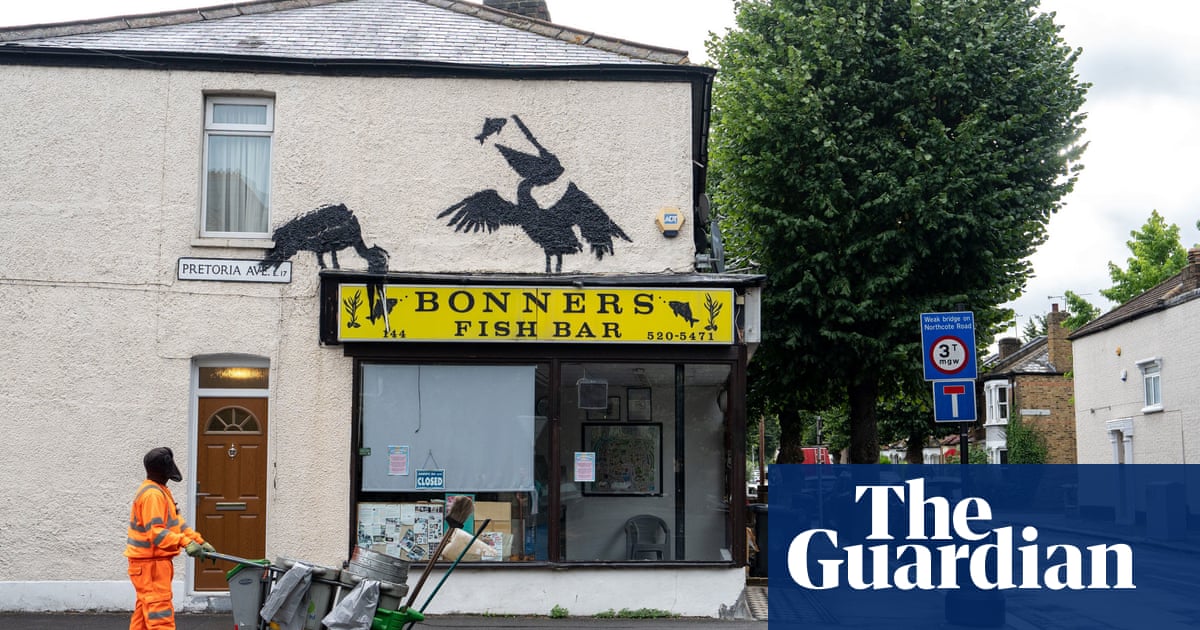It began with the silhouette of a goat perched atop a narrow wall near Kew Bridge in London, with tumbling rocks signifying the animal’s perilous position.
Over the course of the week, more silhouettes began popping up around the capital: two elephants with their trunks reaching towards each other from blocked-out windows on the side of a house in Chelsea; three monkeys swinging across a bridge on Brick Lane; and a wolf howling towards the sky, painted on to the face of a satellite dish on Rye Lane in Peckham.
On Friday, a fifth silhouette, of two pelicans eating fish, appeared on the wall of a Walthamstow fish and chip shop.
The cryptic murals are thought to be the work of Banksy. The Bristol-based street artist, whose identity is unknown, appears to have confirmed the pieces as genuine on his Instagram but he did not caption any of them – fuelling fierce speculation over their meaning.
Some social media users began calling the collection the “London zoo” series and developed a theory that Banksy could be likening the recent far-right rioters to animals. Others linked the images to Gaza, the climate crisis and extinction, Michelangelo’s Creation of Adam and the precarious nature of social media.
Paul Gough, the vice-chancellor of Arts University Bournemouth and author of Banksy: The Bristol Legacy, said it was quite unusual for the artist to trail a series of works in this way.
“By releasing images quickly through the social media site he’s eliminated the ‘whodunnit’ part of the process, which normally obsesses global media,” he said.
“Banksy has often used animals to convey urgent messages about environmental issues, threats to habitat, and the impact of climate change. But they are also powerful metaphors for the state of global politics and the troubled world we have created. Domestic animals – cows, pigs and sheep – are invariably augmented by less savoury beasts – chimps, rats – sporting acerbic placards with an air of playful thuggery.”
Gough, an artist himself who was the subject of Tik Tok rumours that he was Banksy, posited that he could be aiming to release an image a day with a grand reveal sometime around the weekend.
“What he’s doing so far is creating a menagerie of animals, a bestiary of beasts, which will keep stimulating attention and raising the stakes. It’s Banksy’s marketing at its best and most impactive, building an enormous air of expectation.
“The work is instantly accessible. It’s rarely over-complicated visually, yet its simplicity – stencils and iconic designs – imprint themselves on your memory, but with a message that resonates because it is exactly attuned to global issues. It’s art with an edge.”
Dr Isobel Harbison, a lecturer in critical studies at Goldsmiths, University of London, was perplexed by the images and the buzz around them.
“They’re very basic in lots of ways,” she said. “There might be something meaningful about their common silhouette style – not two-tone, as usual – and the fact of their plurality.” She said the appearances of different animals showed the artist was “building quite a congress”.
“The message might be about the environment, ecology or harmony between the built and natural world. If there is a message we need to glean from our environment this week in London, I think it should be one of acceptance and mutual respect.
“But Banksy’s views are usually quite self-evident, so it is unlikely to remain mysterious for long … I do hope [the art] stays on the walls. It’s a good thing that people are looking up, out and around.”
after newsletter promotion
Like a number of Banksy’s previous works, the Peckham wolf was stolen hours after it went on display. Three men were pictured using a ladder to remove the satellite dish from a roof.
The theft cements the fact that Banksy is no longer just a street artist working in the shadows. His paintings have set numerous records at auction, including his seminal Love is in the Bin, which sold at Sotheby’s for £18.6m in 2021 and was described as the “pre-eminent artwork of the 21st century”.
For the Guardian art critic Jonathan Jones, all this is a sign that Banksy “has gone establishment”.
“He’s become a national treasure, and that’s not a good look for a street artist,” Jones said. “Our collective obsession with these new cutesy images is not a good look for us either. It’s a bit pathetic really.
“These bland silhouettes of animals would not be out of place in the Royal Academy summer exhibition. What’s provocative, insightful or interesting about them? Is anyone really excited to see which animal comes next?”
Jones said there was obviously a place for beautiful art that made us happy but doubted whether anyone would turn to Banksy for that.
“He does crude stencils without nuance. These animals are no exception. They give you nothing visually, just a social media buzz. He makes images to talk about, not art to reflect on. He is the enemy of sensitivity, the philistine’s revenge, an artist for people too lazy and narcissistic to open themselves to real art.”
For Jones, the best thing Banksy could do next was “quit monkeying about, retire and reveal who he really is, because these insipid stencils have nothing to say or to show us. Or perhaps we’ve all got it wrong and this is a commercial teaser campaign: in a few days Banksy will announce his new tropical soft drink or clothing brand.”
Gough reiterated that it was important for Banksy to keep his brand in the public eye. “One ploy he has favoured of late is a video release alongside an artwork … Could we expect to see a Banksy-esque Johnny Morris and Animal Magic perhaps?”

